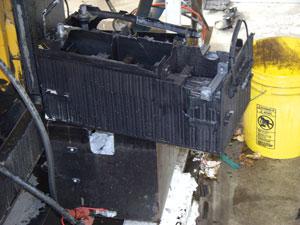|
They now deal with new generation batteries, new generation charging systems, and new generation dangerous situations, says Mike Ross, owner and manager of Mike says with technology such as calcium-calcium batteries, hybrid cars, stop start systems, and battery sensors auto electricians often spend thousands of dollars on training and information to stay ahead of developments, in addition to stocking up on expensive, sophisticated scanning equipment. "We deal with a lot more issues than before...finding the reason why warning lights are illuminated in the dashboard and if the reason is an electronic fault, finding the correct cause and repairing it," he says. In addition to all the complicated electrical systems around, For example, hybrid cars present with high voltages and high current. "Working on these is not for DIY enthusiasts – the shock potential is high. It is necessary in particular with young workers that they know what to do and what protective equipment to use," he says. Ross says workshop owners cannot be careful enough about instructing young employees in the dangers of battery explosions. Such an occurrence came to his attention recently when the young technician it happened to asked a network of colleagues for their opinion, on the basis of the incident report and three photographs. The business where the explosion happened uses a big stationary Cat A colleague who was working outside came running into the shop and reported the explosion, describing it as "things are flying all over the place". On closer inspection, it became apparent the four month old industrial wet cell lead acid battery exploded and blew its contents over the surrounding area. The battery had a 115 VAC 1 amp battery maintainer connected to it to keep it charged up. The technician observed the battery obviously "had a load of hydrogen gas built up" and wanted to know why, and what might have set the explosion off. He also wanted to know whether the battery maintainer kept the battery producing the hydrogen gas, and whether it is possible the battery may have had plugged vent caps, causing the battery to blow. Miraculously nobody was hurt. The technician immediately mixed up several litres of soda and water and neutralised the acid contamination, then hosed the area down. |
Ross says from what he can see the ignition started in the right hand cell and was probably due to a bad connection inside that cell. "It overheated or sparked under load upon starting, causing a chain reaction. Lead acid batteries produce hydrogen and oxygen during charging and yes, the battery maintainer would contribute to this. "However this is very normal. I would be surprised if the caps had blocked and, if they had, caused this - other factors would have had to contribute for his sort of outcome, and it was probably the battery itself that caused this explosion due to a poor formation at the connector bar inside the battery," he says. Ross advised the business owner to have the charger, battery maintainer, and cells checked to get a more accurate conclusion as to the cause. He says the main thing to remember is sparks or open flames near a battery while connected to a charger are always dangerous, as charging produces hydrogen and oxygen, which are flammable. It is also important to ensure the connections are good. Overcharging makes it worse. "If overcharging is severe and the ventilation is inadequate or the battery is faulty, an extremely explosive concentration of hydrogen and oxygen can build up in the cell or battery enclosure. A spark could then cause a huge explosion. This will damage the battery and disperse sulphuric acid into the surroundings, damaging the environment and injuring people in it, too," he says. Ross also cautions technicians to look out for batteries with swollen ends, or batteries that are hot to touch. This usually indicates malfunctioning in the car’s charging system, for example a faulty regulator an unregulated alternator that puts out a too high level of charge. The swelling can be the result of plate distortion due to the excessive heat built up from overcharging, and or abnormally high levels of hydrogen and oxygen. "Check this immediately with your meter to establish the charge rate...this is a dangerous situation. The battery must be given time to cool off and dissipate the gas before handling, and the technician must wear goggles, overalls and gloves, and ensure the environment is spark free," he says. Ross says a battery in this condition is unserviceable and will need replacing after the charging system fault has been rectified, albeit a charging fault or an under bonnet cooling issue. He cautions vehicles that have batteries situated in locations other than under the bonnet rely on a small tube from the battery location to the outside atmosphere for battery ventilation. "The tube ensures gassing that cannot be handled within the confines of the battery itself is safely dispersed outside the vehicle cabin. It is important to ensure this tube is refitted every time the battery is replaced," he says. Under bonnet cooling is another increasingly important requirement for modern cars. "Most vehicles, including hybrids, have ducting and some have cooling fans to try and overcome the combination of high under bonnet temperatures and the natural heat generated by the chemical reaction within the battery. "The technician or auto electrician must pay attention to ensure these cooling and ventilating systems are operating correctly no matter where they are situated in the vehicle. |






